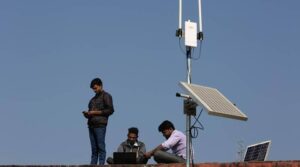
“Why Tech Giants are Failing in Africa’s Last Mile Connectivity: Lessons Learned from Google Loon and Facebook Express Wi-Fi”

The topic everyone talking about today is “Last Mile Connectivity”. When it comes to providing internet access to the most remote and underserved areas of the world, Africa is a prime example of a region where the tech giants have struggled. Projects like Google’s Loon in Kenya and Facebook’s Express Wi-Fi, which promised to bring cheaper internet access to developing parts of the world, have both closed down with little to show for their efforts. So, what went wrong?
One major issue is the lack of partnerships with local innovators. These tech giants often come in with a “one-size-fits-all” approach, trying to impose their own solutions on local communities without truly understanding their unique needs and challenges. This can lead to projects that are not well-suited for the local environment, and that ultimately fail to gain traction. There is a lot of local innovators that understand the local environment working on a multitude of problems including last-mile connectivity and yet most of those big organization believe or prefer not to look at those innovators, or invest in them believing their approach is much better.

One prominent challenge in addressing last-mile connectivity is the misconception that “free internet” alone can solve the problem. While the idea of providing internet access at no cost may seem appealing, the reality is far more complex and costly. Simply giving away internet connectivity without a sustainable business model can have adverse consequences and hinder the development of robust infrastructure and necessary technology to ensure universal accessibility.
It is important to recognize that establishing and maintaining internet connectivity requires significant investments in physical infrastructure, such as broadband cables, towers, and satellite systems. Additionally, ongoing operational costs, including maintenance, upgrades, and technical support, must be considered.
By solely relying on the concept of free internet, there is a risk of neglecting the essential financial resources needed to expand and improve connectivity infrastructure. Without proper funding, infrastructure development may stagnate, limiting the reach and quality of Internet services. This, in turn, perpetuates the digital divide and hampers the potential benefits that widespread internet access can bring.
To achieve sustainable last-mile connectivity, it is crucial to explore innovative business models, public-private partnerships, and regulatory frameworks that encourage investments and foster collaboration among stakeholders. This approach ensures the availability of reliable and affordable Internet services, which can support economic growth, education, healthcare, and social development.
Moreover, sustainable models can leverage diverse funding sources, such as private investments, government subsidies, and community initiatives. These approaches promote the development of a robust ecosystem that fosters competition, drives technological advancements, and addresses the unique needs of underserved communities.
Another critical issue in addressing last-mile connectivity is the absence of a multi-purpose digital infrastructure. In Africa, traditional telecommunications companies have successfully generated revenue from various sources, including mobile money, voice calls, SMS, and internet services. This diversification of revenue streams enables them to maintain a sustainable business model and continue investing in their infrastructure to expand coverage and enhance service quality.
In contrast, many tech giants have primarily focused on providing internet access as their core service offering. While internet access is undoubtedly crucial, relying solely on this single service is insufficient to establish a sustainable model for last-mile connectivity. The limitations of this approach become apparent when considering the complexity and costs associated with building and maintaining digital infrastructure.
By offering a broader range of services, traditional telecommunications companies have been able to leverage the revenue generated from multiple sources to fund infrastructure development and improvement. This diversified approach not only provides financial stability but also ensures a steady flow of resources to support expansion into underserved areas and the implementation of technological advancements.
To bridge the digital divide effectively, it is crucial to adopt a multi-purpose digital infrastructure model. This entails exploring opportunities to integrate various services, including mobile money, digital banking, e-commerce, and other value-added offerings, alongside internet access. By diversifying revenue streams and providing a comprehensive suite of services, companies can create sustainable business models that support ongoing investments in network infrastructure and ensure long-term viability.
Furthermore, a multi-purpose digital infrastructure approach aligns with the evolving needs and demands of users in Africa. It enables individuals and businesses to access a wide range of digital services conveniently, fostering economic growth, digital inclusion, and social development.
Collaboration between tech giants, traditional telecommunications companies, governments, and other stakeholders is vital to develop and implement this multi-purpose digital infrastructure. By combining expertise, resources, and infrastructure, they can create an ecosystem that leverages the strengths of each player to deliver comprehensive and sustainable last-mile connectivity solutions.
One critical aspect where tech giants have encountered challenges is the absence of an investment vehicle for mergers and acquisitions with local tech companies that possess an in-depth understanding of the local environment. By establishing such partnerships, tech giants would have been able to leverage the knowledge, expertise, and insights of these local companies. Collaborative efforts would have paved the way for the creation of solutions that are genuinely tailored to the unique needs and nuances of local communities.
By investing in and partnering with local tech companies, tech giants would have gained a deeper understanding of the local market dynamics, cultural context, regulatory landscape, and user behaviors. These local partners could offer invaluable insights into consumer preferences, infrastructure limitations, and the most effective strategies for last-mile connectivity.
Moreover, such partnerships would have facilitated the transfer of technology, skills, and knowledge between the global tech giants and local companies. This exchange of expertise would have fostered innovation and capacity-building within the local tech ecosystem, empowering it to develop and deliver solutions that align with the specific requirements of African communities.
By working hand-in-hand with local tech companies, the tech giants would have also fostered a sense of ownership and participation among local communities. This collaborative approach acknowledges and values the importance of local expertise, allowing for co-creation and co-design of solutions that truly address the unique challenges faced on the ground.
To exemplify this collaborative approach, references to successful instances of tech giants partnering with local companies can be found in various case studies and reports. For instance, the partnership between Microsoft and Andela, a Nigeria-based tech company, aimed to bridge the digital skills gap and empower African developers. This collaboration demonstrated the potential of combining global resources and local knowledge to drive impactful initiatives.
In conclusion, the failure of these tech giants in Africa’s last-mile connectivity highlights the need for a more collaborative and localized approach. It’s important to involve local innovators and communities in the planning and implementation of internet access projects and to understand the unique needs and challenges faced in different regions. Additionally, sustainable business models and investment in infrastructure and technology are key to the success of last-mile connectivity projects, and building a multi-purpose digital infrastructure can be an effective way to bridge the digital divide in Africa, and that is what we plan to do next at ared


